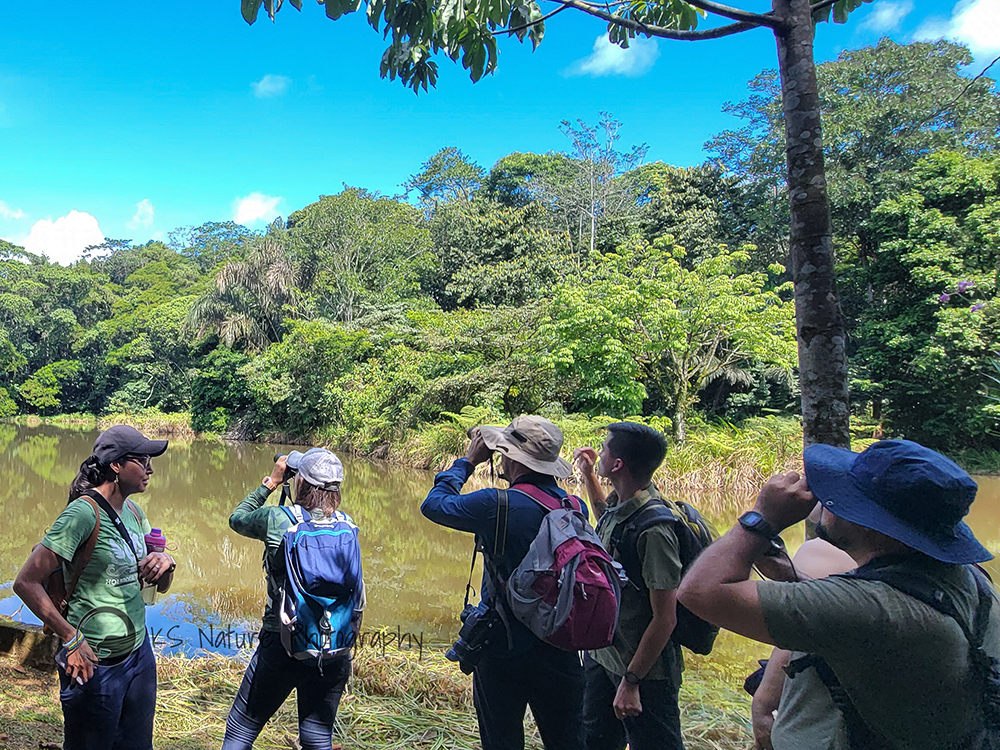 Award-winning nature photographer Krisztina Scheeff led a free photography workshop at the Sarapiquí Conservation Learning Center tailored especially for naturalist guides to provide them with the opportunity to learn or improve their photography skills. The workshop was open to all skill levels, with a main focus on wildlife and nature photography, as the growing popularity of nature photography in the travel industry has made it a valuable skill for those working in this tourism specialty.
Award-winning nature photographer Krisztina Scheeff led a free photography workshop at the Sarapiquí Conservation Learning Center tailored especially for naturalist guides to provide them with the opportunity to learn or improve their photography skills. The workshop was open to all skill levels, with a main focus on wildlife and nature photography, as the growing popularity of nature photography in the travel industry has made it a valuable skill for those working in this tourism specialty.
Selva Verde Lodge Blog
The SCLC is ON A MISSION - News Update
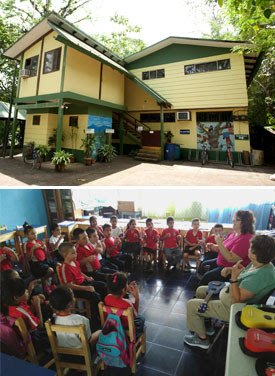 When you experience Selva Verde, you don’t want to miss a trip next door to the Sarapiquí Conservation Learning Center (SCLC). With the mission to link communities and conservation through education and ecotourism in the Sarapiquí region, SCLC continues to thrive! SCLC programs include environmental education, rural tourism activities, English classes, community outreach, women’s groups, and scholarship funds for high school students. Programs are run by international volunteers and community members and serve hundreds of local people and thousands of ecotourists each year.
When you experience Selva Verde, you don’t want to miss a trip next door to the Sarapiquí Conservation Learning Center (SCLC). With the mission to link communities and conservation through education and ecotourism in the Sarapiquí region, SCLC continues to thrive! SCLC programs include environmental education, rural tourism activities, English classes, community outreach, women’s groups, and scholarship funds for high school students. Programs are run by international volunteers and community members and serve hundreds of local people and thousands of ecotourists each year.
What’s New at SCLC:
- The SCLC library reaches the 3,000 mark – With over three thousand volumes of high quality books, residents and visitors have access to information to learn. The library also has magazines, games, reference and audiovisual material for the community – and access to the digital library at the national level
Costa Rica 2017 International Birding Conference
Sponsored in association with American Birding Association, Birdwatcher’s Digest, National Audubon Society, and Swarovski Optik
November 1-5, 2017
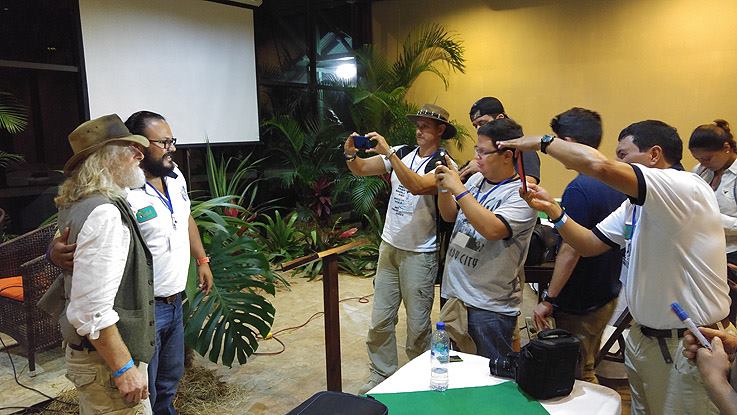 The 2017 Costa Rica International Birding Conference will be held at Selva Verde Lodge & Rainforest Reserve in Sarapiquí, located amid primary and secondary forest in the Caribbean lowlands of Costa Rica. Though small in geographic area, Costa Rica sits at the crossroads of two continents and is a major flyway for birds in the Western Hemisphere. More than 900 bird species have been recorded in the country, making it a hotspot for birding and a priority for conservation.
The 2017 Costa Rica International Birding Conference will be held at Selva Verde Lodge & Rainforest Reserve in Sarapiquí, located amid primary and secondary forest in the Caribbean lowlands of Costa Rica. Though small in geographic area, Costa Rica sits at the crossroads of two continents and is a major flyway for birds in the Western Hemisphere. More than 900 bird species have been recorded in the country, making it a hotspot for birding and a priority for conservation.
The conference is designed for birding organization leaders and representatives who focus on field programs. It features field trips, seminars and presentations on Costa Rica and international topics, such as National Audubon’s International Alliances Program, ABA’s Youth Birding Initiative, and local birding tours that promote sustainable development and community building. Come and learn about these hopeful efforts to protect and manage birds throughout the Americas, share with your peers, and gain insight for your community initiatives.
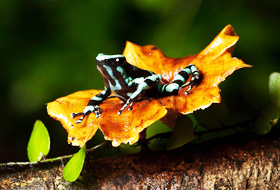
Taller de Fotografía de Naturaleza en Selva Verde Lodge impartido por Jaime Culebras (Septiembre 8-12, 2017)
El renombrado fotógrafo Jaime Culebras estará ofreciendo un taller en Selva Verde Lodge sobre fotografía de la Naturaleza. Por 5 días, los participantes exploraran la increíble biodiversidad de Sarapiquí, y aprenderán como capturarla en su esplendor!. adicionalmente el herpetologista Cesar Barrio Amorós, estará presente en el taller. El taller será presentado en Español.
Únete a Jaime Culebras en Selva Verde Lodge Reserva Privada para un taller de 5 días explorando la increíble biodiversidad de Sarapiquí y aprendiendo a capturarla en su mejor momento! Además, nuestro buen amigo, el herpetólogo Cesar Barrio Amorós, estará presente en el taller.
No se trata de ceñirse a aprender sobre el manejo de una cámara, sino llegar más allá, entrenar la mente y ojo para hacer de la fotografía nuestro mejor aliado para plasmar en pequeños instantes imborrables los mejores momentos que vivimos en la naturaleza. Se trata de visualizar la foto antes de realizarla, aprender sobre las condiciones ambientales y del medio para así poder aprovechar cada instante en el campo, marcando la diferencia entre la típica foto y una foto que rompe lo cotidiano.
Selva Verde Lodge tiene la suerte de encontrarse en un enclave incomparable, las tierras bajas de la vertiente atlántica de Sarapiquí, una región con una explosión de formas y colores naturales que le confiere un valor añadido a este taller, para exprimir al máximo ese enigmático mundo que es la fotografía de naturaleza.
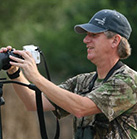 Clay Taylor, Leader and Naturalist Market Manager for Swarovski Optik Make your reservation to see spectacular avian diversity, and then leave your binoculars and spotting scope at home. Sound crazy? Not when Eagle Optics and Swarovski Optik team up to offer you an amazing bird trip and outfit you with top-notch Swarovski binoculars. Costa Rica is famous among birdwatchers; this small country encompasses only 0.03% of the earth’s surface, yet provides sanctuary for nearly 900 species of birds or 5% of the world’s biodiversity.
Clay Taylor, Leader and Naturalist Market Manager for Swarovski Optik Make your reservation to see spectacular avian diversity, and then leave your binoculars and spotting scope at home. Sound crazy? Not when Eagle Optics and Swarovski Optik team up to offer you an amazing bird trip and outfit you with top-notch Swarovski binoculars. Costa Rica is famous among birdwatchers; this small country encompasses only 0.03% of the earth’s surface, yet provides sanctuary for nearly 900 species of birds or 5% of the world’s biodiversity.
Join Swarovski, Eagle Optics, and an expert Costa Rican guide to see tropical birds like you have never seen them before. With a limited number of spaces available, you should make your reservation now. Once the trip is over and you are convinced you can never go birding again without Swarovski Optiks, you have the opportunity to purchase the Swarovski binoculars at a discounted price. Sign up now for a Swarovski birding experience you’ll never forget!
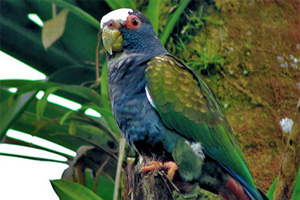 White-crowned Parrot
White-crowned Parrot
The white-crowned parrot is a small, perky and robust bird with a disproportionately large head. It is common and widely-distributed in Costa Rica, most often encountered in semi-open agricultural areas with scattered patchy trees. The species is abundant in the Selva Verde vicinity where it is characteristically most active in the early morning and late afternoon.
These parrots are almost entirely arboreal. They virtually never forage on the ground. Their main diet comprises the seeds, nuts and fruit of palms, Inga and Erythrina, sometimes damaging orchard fruit or corn.
White-crowned parrots are extremely social birds, spending most of their time in flocks with 30-50 members. Each flock is a highly-organized social unit, lacking any specific flock leader, but having a complicated structure shaped by the necessity to detect and avoid predators.
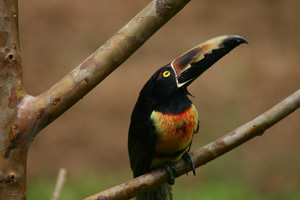 Robert Alison photo
Robert Alison photo
The collared aracari is a small awkward-looking toucan with a prominent enormously-oversized bill. It is fairly common throughout its 500,000 square mile Latin American range, and frequently seen at Selva Verde Lodge, where groups of aracaris often visit bird feeders and forage in local fruiting trees.
All 35 members of the toucan family occur exclusively in the New World tropics. There are 14 species of aracaris, all with slender bodies, richly-colored plumage and banana-shaped hollow bills. None of them are usually found far from forested areas, and most are generally encountered in groups of 6-16 individuals.
Collared aracaris seem to do everything in groups; foraging, loafing and even sleeping together. These birds are among the 16 species of Neotropical birds that have elaborate kinship behavior that includes cooperative care of offspring by non-parents. Research in Costa Rica
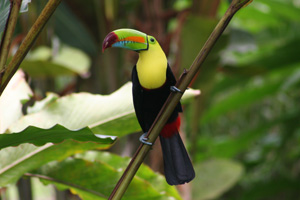 Keel-Billed Toucan
Keel-Billed Toucan
Its rainbow-colored banana-shaped bill is its main distinguishing feature. The structure is actually hollow and comparatively weightless, its keratin skin shaped by slivers of bone. Despite its large size, the bill is used with great dexterity, to toss food items into the air; the head is then flipped upward so the food falls into the mouth. The main diet comprises fruit, the seeds of which are excreted whole; consequently, this toucan is an important disperser of forest seeds.
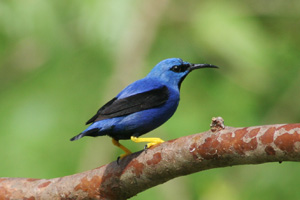 Shining Honeycreeper
Shining Honeycreeper
The shining honeycreeper (Cyanerpes lucidus) is one of two similar and strikingly-colored honeycreepers common in upper level forests and semi-open areas of Costa Rica. The bright yellow legs and feet of the shining honeycreeper are a primary distinguishing feature. At Selva Verde, it is most often encountered in pairs or small family groups. Although its prominent curved beak is specialized for nectar feeding, its main diet comprises succulent fruit.
The call is an unimpressive series of sharp staccato chitters, often intermixed with high thin peets. Researchers confirm this species illustrates the general rule that birds with elaborate colorful plumage often have inferior vocal endowments.
After pair formation, males of this species use song to stimulate females and to maintain the pair-bond. Often, song is used by both adults simultaneously, in duet fashion. Tests show that in this species, there is much individual variation in vocal components and local song dialects occur. The high degree of individuality in song is important for pair members attempting to maintain contact in thick cover.
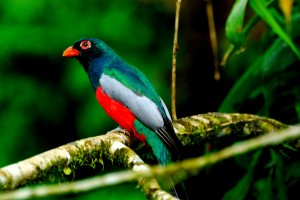 Slaty Tailed Trogon
Slaty Tailed Trogon
The slaty-tailed trogon (Trogon massena) is one of 40 species of trogons with similarly compact bodies, arboreal habits and colorful plumages. Most are sedate and characteristically perch upright, with the tail almost vertically downward. The flight is typically undulating, with brief spurts of rapid wing beats, and is silent. The birds perch in one location, rarely hopping or stepping from branch to branch; the feet are small and appropriate only for stationary perching.
They are among several trogon species that regularly occur at Selva Verde, often observed in clearings close to the guest lodgings and dining room, especially early in the morning. They are obligate frugivores, although they sometimes eat insects, and might even consume small lizards on occasion. They focus their foraging activities in the upper and middle levels of lowland forest, where they are especially fond of ficus and palm fruits. They often frequent the fig trees at Selva Verde.







